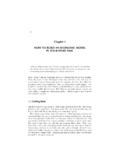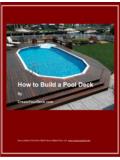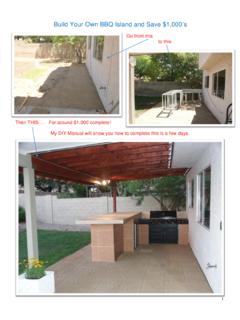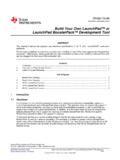Transcription of Build Your Own DI Box! - NF Audio
1 Hand-wired Audio Products Build your Own DI Box! This document will explain step-by-step how to Build your every own passive DI box. I ll try to explain what s happening electronically along the way so you might even learn a thing or two! A DI BOX I suppose a good place to start would be understanding exactly what a DI box does. Most of us as sound-types know that we use a DI box to interface a line level, or instrument level signal with a microphone preamplifier. Essentially to get the instrument level or line level signal to talk to the mic pre happily the DI box does 2 things. Firstly it attenuates the signal quite significantly. Typical line level signals probably range from about 500mV (millivolts) to a bit over 1V. A microphone typically generates a signal as puny as a few millivolts. Hitting the mic pre which is expecting that quiet microphone signal with a full line level signal is not cool, so we use the DI box to drop it right back down to roughly what a microphone would present.
2 The second objective of the DI box is to balance the signal. Guitars, basses and many synthesizers, as you probably already know produce an unbalanced signal which is generally carried on a single conductor shielded cable to an amplifier or similar. Mic preamps generally have either a differential amplifier or a transformer at their input which (without getting too technical) debalances the signal and cancels any induced noise in the process. So presenting our preamp with a balanced signal is a good idea, most of the time! TRANSFORMERS As luck would have it there is a readily available electronic component which will perform both of the above objectives and give us a couple of other benefits too! That device is the transformer. The humble transformer comes in many shapes and sizes, and is useful in a whole host of electronic scenarios. Google electromagnetism and transformers . Have fun. A transformer is essentially two coils of wire suspended near one another.
3 The first coil is known as the primary and the second is known as the secondary. Weird, I know. The two coils sometimes have the same number of turns or windings . In this case, applying a signal to the primary will result in the same signal being produced on the secondary. When the primary and secondary have different turns or windings things start to get interesting. If you applied a signal to a transformer which had more windings on the secondary than on the primary, you would see an amplified signal on the secondary. Similarly if you apply a signal to the primary of a transformer with more windings on the primary than on the secondary, you will see an attenuated signal on the secondary. Do you see where I m headed with this? If we apply our line level (loud) signal to the primary of a transformer with more windings the primary than on the secondary then we will see something quieter (more like mic level?)
4 !?!) on the secondary. A DI box is forming! The ratio between the number of turns on the primary and the secondary is called the turns ratio , by the way. So transformers will typically have a few wires hanging off them in one way or another. 2 of these wires will correspond to the primary, and 2 to the secondary. Of each pair, one will be the beginning of the coil, the other, the end. Typically, the start of the winding would be considered the positive, and the end the negative. If we were interfacing two balanced signals with the transformer, the + and wires from the transformer would simply correspond to our hot and cold signals. If our transformer is interfacing an unbalanced signal with a balanced one, we are obviously left with 1 wire spare. If we ground this wire (connect it to the chassis, or to one of our Audio earths), through the magic of transformers, an out of phase version of the unbalanced signal is presented at the of the opposing coil.
5 That s it balances it! I m not going to explain how that works here, I m sure you re capable of Googling it! This is one of the most handy aspects of transformers, and they re used in gear everywhere specifically for this purpose! If this isn t making sense at this point, don t fret, it will become clearer when you re actually building it! OUR DIY DI BOX So essentially we are going to use a transformer to create a very simple but good sounding and reliable DI box featuring an unbalanced input, a link output for connection to an amp, a ground lift switch and a balanced XLR output. Below is the schematic for the DI box: As you can see, the tip of the INPUT connector is connected to the positive of the primary of the transformer and also to the tip of the THRU. The negative of the transformer primary is grounded, so on the secondary we have both positive and negative (hot and cold) signals. The transformer secondaries connect directly to our XLR outputs pin 2 and 3.
6 The sleeves of both our jack connectors are connected to earth, as is our XLR connectors pin 1 (via a switch). The switch between the XLR pin 1 and earth is our earth lift switch. That s all there is to it! THE PARTS To Build your own DI Box you ll need the following parts: - An Enclosure (aluminum is good for shielding) - A microphone input transformer - 2 x TRS or TS Jacks - 1 x Male XLR Connector - 1 x SPDT Toggle switch or similar - Some hook-up wire - Some solder THE Build The first thing you ll need to do is drill out your enclosure in order to mount the parts inside. This is really easy if you ve got a drill press and you ve done this kind of thing before. If you have not done this kind of metalwork before, then be prepared for the fact that you might ruin a box or two before you get it right. If you re not interested at all, a pre-drilled enclosure is available from my website. Refer to the datasheets for your parts to find the correct sized holes to drill.
7 With your enclosure drilled out you can mount the parts. Depending on the brand/model of transformer you have chosen you will have to work out a way of mounting it to the case. Some transformers come in a shielding can that will have 3mm threaded holes. You can simply make a couple of holes in the enclosure and mount the transformer on the outside in this case. Others, such as Lundahl mic transformers might have a square body with some PCB mounting pins on the bottom. You could even just glue that kind of transformer inside the case and solder some wires to the legs. With all your parts inside the case we can get soldering. The first solder connection we will make is between the input connector, the transformer and the link connector. Take the wire from the positive primary of the transformer and strip about 10mm. Take a short piece of hookup wire (long enough to reach from the tip of your input connector to the tip of your link connector) and strip 10mm from it.
8 Twist the exposed conductors of this wire with the exposed conductors from the transformers positive primary. Tin the wires, trim the exposed conductors to 5mm, tin the tip of the input connector and solder the wires to the connector. Take the other end of the short hookup wire and strip, twist and tin it. Tin the tip of your link connector and solder the hookup wire to it. As you can see, the tip of the input connector is connected to both the positive primary of the transformer, and the tip of the link connector. Next, take the positive of the secondary of the transformer and solder it to pin 2 of your output XLR connector. Solder the negative of the secondary of the transformer and solder it to pin 3 of the XLR connector. Take a short piece of hookup wire and connect pin 1 of the XLR connector to the center pin of your SPDT switch. Now 3 pieces of hookup wire and solder them to: a) The sleeve of your input connector b) The sleeve of your link connector c) One of the free tags on your earth lift switch.
9 Strip the other ends of each piece of hookup wire and twist them together with the negative primary of the transformer. You should have the conductors of 4 wires twisted together at this point. Tin the wires and then solder them to an earth point on the chassis. A good, easy way is to use the earth tag on your XLR connector. That s it! your new DI box is ready to rock and roll!







